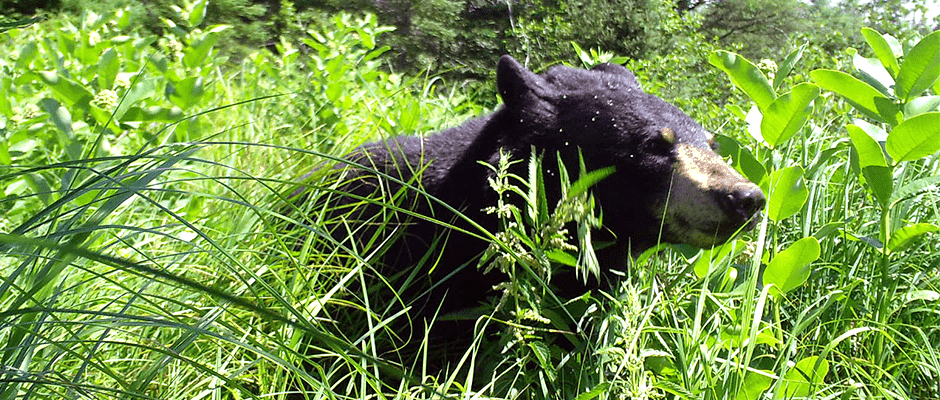Share this article
JWM study: Bait is major food source for northern Wisconsin bears
Bear baiting is a popular hunting technique in Wisconsin, where hunters leave out troves of stale cookies, donuts and candy in hollowed-out logs to habituate black bears (Ursus americanus) in the weeks leading up to the fall hunting season.
But the technique habituates the bears far more than just before the hunt, a new study in the Journal of Wildlife Management found. Studying bears on mostly public lands in northern Wisconsin, biologists found the animals relied on bait for more than 40 percent of their diet — even more than the bears of Yosemite National Park, considered some of the continent’s most food-conditioned bears, relied on human food.
“As an ecologist I would say, any system that we’re subsidizing to that degree is probably going to have ecological consequences, certainly on the bear if not on the system,” said TWS member Rebecca Kirby, the lead author on the study, who was then a graduate student at the University of Wisconsin-Madison.
The prevalence of bait may partly explain why the region’s bear density is more than twice that of neighboring areas in Michigan and Minnesota, where baiting is more restricted, researchers suggested.
“The amount of bait that they’re consuming certainly could be contributing to the high density we have,” she said.
Black bears are hunted in 30 states, including 12 that allow baiting. Regulations vary, researcher found, but on average, bait in other states is allowed for 23 days prior to hunting season. In Wisconsin, baiting is allowed for 145 days before hunting season, from mid-April through early October. That is “virtually the entire active period for bears,” researchers noted.
“In northern Wisconsin, humans are influencing the ecosystem not only through top-down forces via hunting but also through bottom-up forces by subsidizing the food base,” they wrote.
Northern Wisconsin’s bear population is large and growing. An estimated 20,400 bears roam the region. Since 1988, the region’s black bear population has grown 3.4 percent on average, although the rate has slowed in recent years, due to increased harvest.
The Wisconsin Department of Natural Resources estimates more than 15 million liters of bear bait are put out each year, mostly high-calorie human junk food.
The research team took hair, blood and bone samples from harvested bears at hunting registration seasons during the 2011, 2012 and 2013 hunting seasons and performed a stable isotope analysis, comparing what they found in the bears to samples they gathered from bear bait and natural forage.
They found bears appeared to be consuming bait not only in the weeks prior to being harvested but in previous years as well, suggesting that bait played a significant role in their diets “throughout their lives,” regardless of the availability of natural forage. That was especially true for adult male bears. Although the study looked only at harvested bears, Kirby said she expected other bears in the region would show a similar reliance on bait.
“It’s not surprising that they would prefer that,” she said. “They’re omnivores. They’ll go after anything, just like humans. But the amount was surprising.”
Researchers worry this dependence could boost the region’s bear population above its carrying capacity, harm their nutrition, shorten their denning periods, make them dependent on food subsidies and increase the chance of conflicts with humans if the bait is removed.
The team urged wildlife managers to consider baiting restrictions, possibly reducing the baiting period, limiting the number of baits hunters may use and improving bait content.
“I think the amount of bait that we have on the landscape and the fact that 40 percent of a wild animal’s diet is coming from human food is probably not something that is ecologically desirable,” Kirby said. “Regardless of any choices that are made, I think it begs the question, do we need to allow this much bait? Regardless of how you feel about baiting in general, and people have opinions across the board, I think the amount in this case definitely warrants investigation.”
To view the article, members can login to Your Membership, click on “Publications” and then “Journal of Wildlife Management.”
Header Image: A black bear looks out over tall grasses in Wisconsin, where a recent study published in the Journal of Wildlife Management has found that bears rely on bear bait for more than 40 percent of their diet throughout their lives. ©Wisconsin Department of Natural Resources, Snapshot Wisconsin Project








